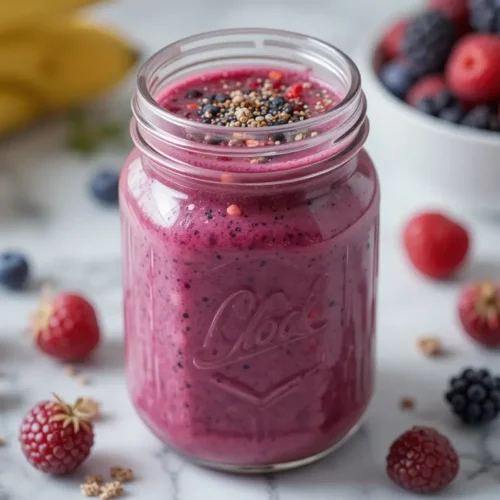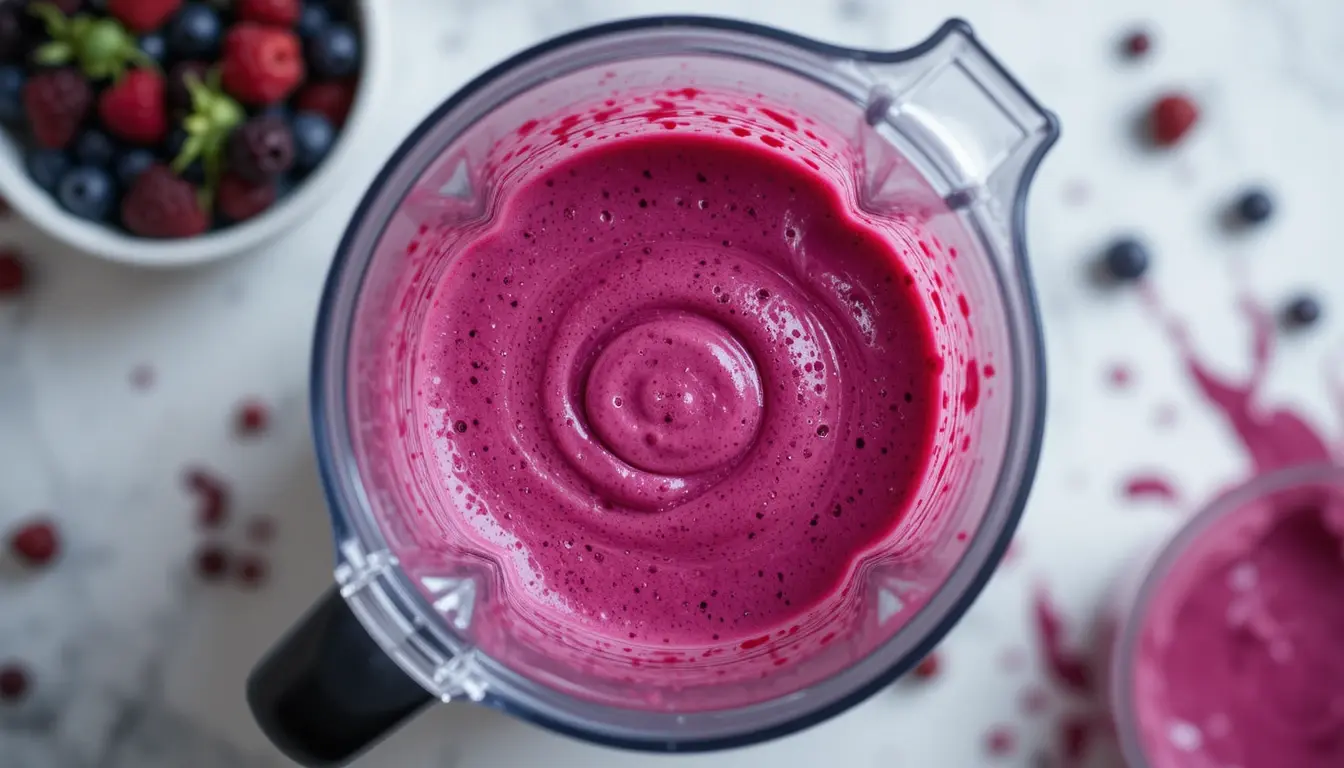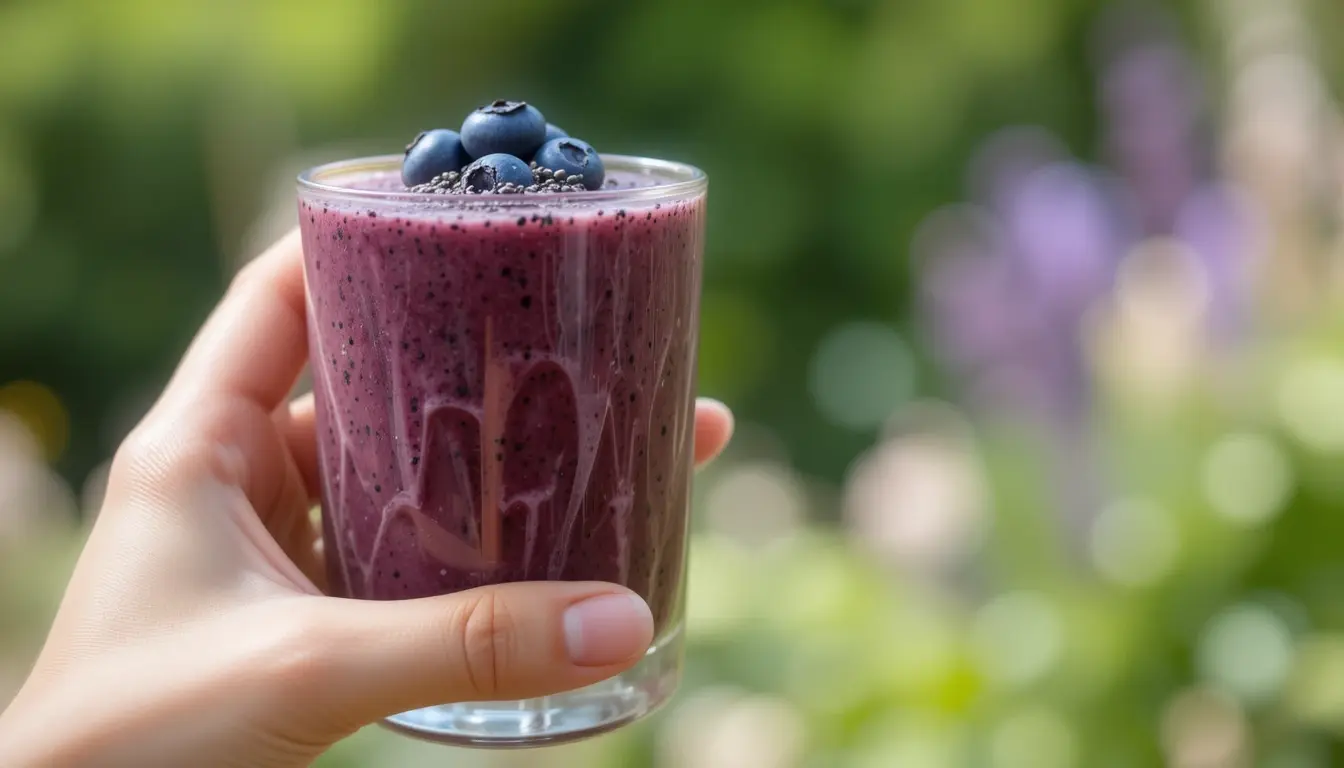Sticking to gluten-free eating doesn’t mean you need to miss out on flavor, creaminess, or satisfaction. In fact, some of the most nourishing blends come straight from your blender. In this guide, we’ll talk about gluten free smoothies that aren’t just healthy, but actually crave-worthy. Whether you’re navigating celiac disease or just feeling better without gluten, these smoothies pack energy, nutrition, and joy into every glass. You’ll learn how to make them, what ingredients to use, and what to avoid. We’ll also answer common questions about fruit, gluten contamination, and how often to enjoy a smoothie. Let’s start blending.
Table of Contents
Gluten Free Smoothies
Why Gluten Free Smoothies Matter
The Heart of a Clean Start
Years ago, I didn’t think twice about what went into my breakfast. Muffins, toast, cereal if it was fast, it was fine. But something didn’t feel right. I often felt tired by mid-morning and never quite clear-headed. When I finally removed gluten from my meals, everything changed. My energy came back. My mind felt sharper. But I needed new breakfast habits. That’s when gluten free smoothies became my staple.
Now I live just outside Asheville, North Carolina, where local fruit is abundant and food is rooted in season and story. My favorite smoothie recipe started with ingredients I had on hand after one of my early morning farmers’ market runs. A ripe banana. A bag of frozen strawberries. Fresh blueberries. I added almond milk, a spoonful of peanut butter, and chia seeds. What came out of the blender was smooth, creamy, and deeply satisfying. And best of all, it was entirely gluten-free.
If you’re new to eating this way, know that you’re not alone. You don’t need a cabinet full of superfood powders or expensive supplements. You just need simple ingredients that support how you want to feel.
For a cozy pairing on cooler mornings, I often serve this smoothie with a slice of gluten-free banana bread. It’s the kind of breakfast that feels like care, not compromise.
A Simple Daily Habit That Fuels You
Every morning, I start my day with a glass of something blended. There’s something grounding about it. No decisions to make, no labels to double-check. Just a clean mix of fruit, plant-based milk, and a few extras to keep me full and focused.
This particular gluten free smoothies is my favorite for a reason. The banana gives it natural sweetness and body. Frozen strawberries keep it cool and bright. Blueberries add a bit of tart balance. Almond milk makes it light, while peanut butter adds protein and richness. Chia seeds bring fiber and a bit of texture. It takes five minutes, no more.
Everything in this recipe is naturally free of gluten. That means no hidden additives, no guesswork, and no uneasy aftermath. It’s the kind of recipe you can rely on when you’re busy or just need something easy that still makes you feel good.
If you’re craving more ways to start the day, try a batch of cottage cheese banana pancakes with your smoothie. They’re warm, fluffy, and completely gluten-free.
Smoothies have become more than a recipe for me. They’re a ritual, a reset, and a reminder that simple food can be deeply nourishing.

Creamy Gluten Free Smoothies with Berries & Chia
Ingredients
- 1 ripe banana
- 1 cup frozen strawberries
- ½ cup blueberries
- 1 cup unsweetened almond milk or any certified gluten-free plant-based milk
- 1 tablespoon chia seeds
- 1 tablespoon natural peanut butter
- Optional: 1–2 teaspoons raw honey or pure maple syrup
Instructions
- Add banana, strawberries, blueberries, almond milk, chia seeds, and peanut butter to a blender.
- Blend on high until smooth and creamy, about 30–45 seconds.
- Taste and add honey or maple syrup if additional sweetness is desired.
- Pour into a chilled glass and serve immediately.
Notes
- Make it nut-free by using sunflower seed butter and oat milk (certified gluten-free).
- Add a scoop of gluten-free protein powder if using this as a meal replacement.
- Rotate fruit seasonally for variety peaches in summer, citrus in winter.
- Freeze leftover smoothie into popsicle molds for a gluten-free frozen treat.
Nutrition (Approximate)
Nutrient Amount Calories 290 kcal Protein 7g Fat 13g Saturated Fat 2g Unsaturated Fat 11g Cholesterol 0mg Carbohydrates 36g Fiber 8g Sugar 20g (natural) Sodium 80mg Trans Fat 0g
Gluten Free Smoothies Ingredients That Work
Whole Foods That Naturally Work
The beauty of gluten free smoothies is that you don’t have to reinvent your kitchen. With just a few whole ingredients, you can build blends that taste amazing and fuel your body. Most fruits, seeds, and dairy-free milks are naturally gluten-free, so you’re already halfway there.
Bananas, strawberries, blueberries, and mangoes are classic smoothie staples. They add natural sweetness, fiber, and a smooth texture when frozen. Greens like spinach or kale blend easily into fruit without making the flavor too “green.” One frozen banana, in particular, creates a thick, creamy base with no ice needed.
As for liquids, almond milk is a favorite, but you can also use oat or coconut milk just make sure the label says “gluten-free.” Some brands sneak in additives that may contain gluten, especially flavored versions.
Boost the nutrition with chia seeds, flaxseed, or hemp hearts. These tiny additions support digestion, keep you full longer, and add a satisfying texture. A spoonful of natural peanut butter adds plant-based protein and a creamy, nutty finish. You can also sweeten naturally with a touch of maple syrup or raw honey, but fruit usually does the job.
One of my favorite options for a cozy twist is this banana bread latte smoothie, which is naturally gluten-free and packed with flavor.
Smoothies are an easy, effective way to stay gluten-free without feeling restricted. You’ll quickly find that simple blends offer the best results.

Common Pitfalls to Avoid
Not all smoothie ingredients are as safe as they look. Many people assume everything that sounds healthy is gluten-free, but that’s not always true. Even the cleanest-looking smoothies can go wrong if you’re not careful.
Gluten often hides in protein powders, flavored yogurts, and oat-based products. Oats themselves don’t contain gluten, but they’re often processed on shared equipment. Always look for “certified gluten-free” on oats and oat milk to avoid cross-contamination.
Nut butters are another area to double-check. Some include added sweeteners or thickeners that contain gluten. Choose simple options just nuts and salt.
Read every label. Flavored almond milk or yogurt may have additives derived from wheat. Even granola toppings, often used as smoothie garnishes, can sneak in gluten unless you make them yourself.
When you blend at home, you control every ingredient. That’s the real power of gluten free smoothies you’re not guessing. You’re choosing what works for your body.
If you’re transitioning to gluten-free living, my banana bread recipe is another easy win. It pairs beautifully with any smoothie and uses everyday ingredients you can trust.
Making your smoothies gluten-free isn’t about restriction. It’s about confidence. When you know your ingredients, every sip feels like a step forward. That’s the beauty of making your own gluten free smoothies they empower your wellness journey.

How to Blend the Perfect Gluten Free Smoothies
Tips for Flavor and Texture
Making gluten free smoothies at home isn’t just about avoiding gluten. It’s about getting the right taste and consistency every time. A few simple techniques can take your smoothie from basic to something you crave daily.
First, use frozen fruit instead of ice. Ice waters things down, while frozen bananas or berries keep the texture thick and the flavor bold. Always add the liquid first to help the blades move easily. Then layer in your soft ingredients like banana or yogurt, followed by nut butters or seeds.
For the best texture, blend in stages. Start on low speed, then increase gradually. If it’s too thick, add more almond milk a little at a time. If it’s too thin, toss in a few more frozen berries or a second half banana. Your goal is creamy, not watery.
Balance is everything. One creamy base, one tart fruit, and a touch of sweet works well. Banana and peanut butter are creamy, while strawberries or blueberries offer that fresh tang. A dash of cinnamon or a drop of vanilla can brighten the flavor without adding sugar.
For more thick and satisfying combos, try my sweet potato smoothies or explore this peanut butter blast variation.
Smoothies aren’t complicated, but attention to small details creates that silky finish every time.
When and How Often to Enjoy Them
One of the most common questions I get is whether you can have gluten free smoothies every day. The answer is yes if they’re balanced. A smoothie can be a full meal if it includes protein, fiber, and healthy fats.
Morning is the perfect time. Your body is ready to absorb nutrients, and it sets your energy tone for the day. But smoothies work great post-workout, as a snack, or even for a light dinner.
If you’re drinking one daily, keep an eye on variety. Rotate your fruits and greens. Switch between chia, flax, and hemp. This keeps your body happy and prevents boredom.
Smoothies give you endless flexibility. You can pack in nutrition, adjust to your mood, and still stick to your gluten-free goals. With just a few tweaks, your daily habit becomes a foundation of healthy gluten free smoothies you actually enjoy. They’re easy to digest, quick to make, and ideal for busy mornings or reset moments.
Making them at home ensures total control, which is especially important when you need to avoid gluten without guessing.
Gluten Free Smoothie Variations & Add-Ins
Creative Additions Without Risk
Once you’ve mastered a few basic gluten free smoothies, the real fun begins customizing them with safe and flavorful extras. Add-ins are a great way to bring variety, boost nutrition, and change up texture without ever using ingredients that could cause a reaction.
Start with spices. A dash of cinnamon adds warmth and helps regulate blood sugar. Ginger brings a refreshing kick and supports digestion. Vanilla extract rounds out sweetness naturally without using sugar.
You can also add a spoonful of cacao powder or cacao nibs for a chocolatey boost. These are naturally gluten-free and rich in antioxidants. For extra creaminess, try frozen avocado it blends smoothly and doesn’t overwhelm other flavors.
Seeds are excellent choices for both nutrition and texture. Chia, flax, and hemp seeds all add fiber, omega-3s, and subtle nutty notes. Rotate them to keep your body guessing and your smoothies fresh.
For a satisfying texture, shredded coconut or a spoonful of almond butter works beautifully. It adds richness without overpowering the fruit.
If you’re feeling creative, try blending your smoothie into a bowl and topping it with gluten-free granola or thinly sliced fruit. It becomes more of a meal than a drink.
Smoothies are flexible, so you never have to get bored.
Seasonal Inspiration for Gluten Free Smoothies
One of the easiest ways to keep gluten free smoothies interesting is to change them with the seasons. Fresh ingredients taste better, cost less, and often blend more smoothly than off-season picks.
In spring, use fresh berries, spinach, and lemon. Summer brings peaches, cherries, and juicy melons. Freeze them to keep the smoothie cool and thick without adding ice. Fall is ideal for apples, cinnamon, and almond milk. You can even roast your fruit before blending for deeper flavor.
Winter is perfect for citrus. Try orange segments, ginger, and a touch of vanilla. These ingredients brighten dark mornings and support your immune system.
If you’re looking for gluten-free inspiration year-round, check out my pink salt weight-loss smoothie. It’s simple, unique, and naturally gluten-free.
Building your smoothie around what’s in season keeps things exciting. It also makes your routine sustainable and satisfying. Rotating seasonal fruits also helps introduce variety into your gluten free smoothies, so they never feel repetitive.
Frequently Asked Questions About Gluten Free Smoothies
Are smoothies gluten-free?
Most smoothies are naturally gluten-free, especially when made with whole ingredients like fruit, plant-based milk, seeds, and nut butter. The risk comes from pre-made mixes, flavored yogurts, or granola toppings that may contain gluten. When blending at home, you control every element, so it’s easy to keep your smoothies 100% gluten-free.
What fruit is good for gluten-free?
Almost all fresh fruit is naturally gluten-free. Bananas, strawberries, blueberries, mangoes, apples, and peaches are safe and delicious smoothie options. Always rinse well and use fresh or frozen varieties without added sweeteners or coatings. Pair fruits with gluten-free liquids and clean protein sources to build balanced gluten free smoothies.
What is surprisingly not gluten-free?
Some ingredients that appear healthy may hide gluten. Examples include some oat milk brands, flavored yogurts, granola, malted chocolate, and certain protein powders. Always read labels. Look for “certified gluten-free” to stay safe. When it comes to gluten free smoothies, stick with whole foods and simple combinations to avoid surprises.
What is the rule 3 for smoothies?
The “Rule of 3” refers to a smoothie formula: 1 base, 1 fruit, 1 booster. For example, almond milk as a base, banana for sweetness, and chia seeds for nutrition. This simple guideline helps create balanced gluten free smoothies that taste great and keep you full.
What should you not mix in a smoothie?
Avoid adding sugary juices, flavored yogurts, or sweetened nut butters. These often contain hidden gluten and unnecessary additives. Also steer clear of low-quality protein powders unless they’re certified gluten-free. Keeping your smoothie simple and ingredient-conscious is the safest and most effective approach.
Is a smoothie every day ok?
Yes, a smoothie every day can be a healthy habit as long as it’s balanced. Use whole fruit, plant-based protein, and healthy fats. Avoid turning your smoothie into a sugar bomb. Daily gluten free smoothies made with clean ingredients support digestion, energy, and long-term wellness.
Conclusion
Gluten free smoothies aren’t a trend in my kitchen they’re a habit rooted in feeling better, thinking clearer, and eating food that supports the body without overcomplicating it. With the right ingredients, you can blend something nourishing in just minutes, no need for processed powders or store-bought blends.
Whether you’re starting your morning, recharging after a walk, or just craving something fresh and clean, these smoothies offer real food that works for your lifestyle. Keep your ingredients honest. Trust your taste. And remember what’s blended with care becomes part of how you care for yourself. That’s what makes gluten free smoothies such a smart and soulful habit.

